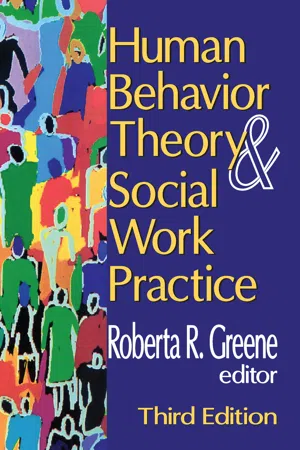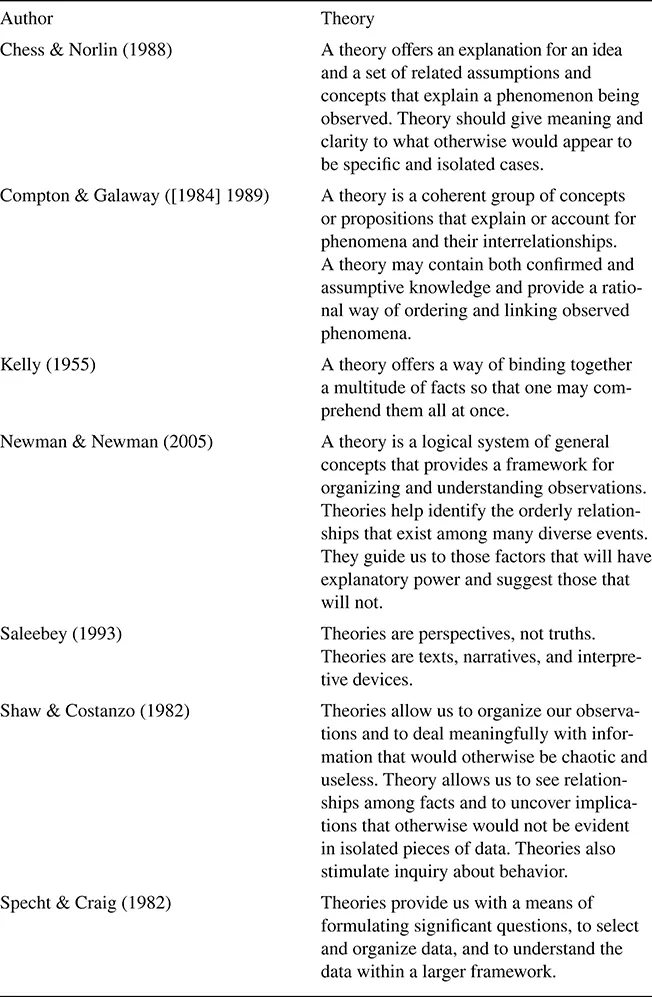
- 352 pages
- English
- ePUB (mobile friendly)
- Available on iOS & Android
Human Behavior Theory and Social Work Practice
About this book
Human Behavior Theory and Social Work Practice remains a foundation work for those interested in the practice and teaching of social work. Roberta Greene covers theoretical areas and individual theorists including classical psychoanalytic thought, Eriksonian theory, Carl Rogers, cognitive theory, systems theory, ecological perspectives, social construction, feminism, and genetics. She discusses the historical context, its philosophical roots, and major assumptions of each theory. The general theme, which distinguishes this volume, is that the person-in-environment perspective has been a central influence in the formation of the profession's knowledge base, as well as its approach to practice. Greene provides perspective on how individuals and social systems interact.
This book examines how social workers can use theory to shape social work practice by increasing his or her understanding of and potential for enhancing human well-being. Greene covers the relationship between human behavior theory and professional social work practice. She also explores the challenges and limitations of each theory and addresses the following issues: how the theory serves as a framework for social work practice; how the theory lends itself to an understanding of individual, family, group, community, or organizational behavior; what the implications are of the theory for social work interventions or practice strategies; and what role it proposes for the social worker as a change agent.
Throughout the profession's history, social workers have turned to a number of theoretical approaches for the organizing concepts needed to define their practice base. The aims of social work--to improve societal conditions and to enhance social functioning of and between individuals, families, and groups--are put into action across all fields of practice and realized through a variety of methods in a range of settings. This third edition, completely revised, represents a fundamental contribution to the field, and like its predecessors, will be widely used as a basic text.
Frequently asked questions
- Essential is ideal for learners and professionals who enjoy exploring a wide range of subjects. Access the Essential Library with 800,000+ trusted titles and best-sellers across business, personal growth, and the humanities. Includes unlimited reading time and Standard Read Aloud voice.
- Complete: Perfect for advanced learners and researchers needing full, unrestricted access. Unlock 1.4M+ books across hundreds of subjects, including academic and specialized titles. The Complete Plan also includes advanced features like Premium Read Aloud and Research Assistant.
Please note we cannot support devices running on iOS 13 and Android 7 or earlier. Learn more about using the app.
Information
1
Human Behavior Theory, Person-in-Environment, and Social Work Method
Organization of the Chapters
- What does the theory offer for understanding development across the life cycle? Life course?
- What does the theory suggest about the interactions among biological, psychological, and sociocultural factors of human development and functioning?
- What does the theory suggest about healthy/functional and unhealthy/dysfunctional behaviors or wellness?
- What does the theory say is adaptive/maladaptive? How does the theory present stress factors and coping potentials?
- Is the theory universal in its application? How does the theory lend itself to cross-cultural social work practice or various life contexts? Does the theory address social and economic justice?
- What does the theory propose about individuals as members of families, groups, communities, and organizations?
- How does the theory serve as a framework for social work practice?
- How does the theory lend itself to an understanding of individual, family, group, community, or organizational behavior?
- How does the theory suggest the client and social worker go about defining presenting situations, problems, or concerns? Does the theory suggest a strengths perspective?
- What are the implications of the theory for social work interventions or practice strategies? Do the principles of the theory emphasize a client’s capabilities and resources?
- what does the theory suggest the social worker do? What does it suggest the client (system) do?
- What role does it propose for the social worker as change agent? What is the aim of treatment/intervention or meaning creation? What does it suggest enhances functioning or promotes change in the client? In society? In societal institutions?
Human Behavior Theory, Positivist Tradition, and Reliance on Scientific Thought
Changes in Epistemology
The Value of Theory
Value of a Theoretical Framework

Definitions of Theory

Table of contents
- Cover
- Half Title
- Title Page
- Copyright
- Table of Contents
- 1. Human Behavior Theory, Person-in-Environment, and Social Work Method
- 2. Human Behavior Theory and Professional Social Work Practice
- 3. Classical Psychoanalytic Thought, Contemporary Developments, and Clinical Social Work Practice
- 4. Eriksonian Theory: A Developmental Approach to Ego Mastery
- 5. Carl Rogers and the Person-Centered Approach
- 6. Cognitive Theory For Social Work Practice
- 7. General Systems Theory
- 8. Ecological Perspective: An Eclectic Theoretical Framework for Social Work Practice
- 9. Social Construction
- 10. Feminist Theories and Social Work Practice
- 11. Human Behavior Theory and Social Work Practice: Genetics, Environment, and Development
- 12. Risk and Resilience Theory: A Social Work Perspective
- Index